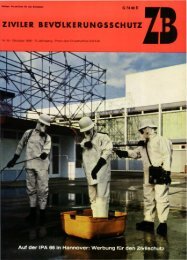Zivilschutz- Forschung - Bundesverwaltungsamt
Zivilschutz- Forschung - Bundesverwaltungsamt
Zivilschutz- Forschung - Bundesverwaltungsamt
Sie wollen auch ein ePaper? Erhöhen Sie die Reichweite Ihrer Titel.
YUMPU macht aus Druck-PDFs automatisch weboptimierte ePaper, die Google liebt.
19. Benjamin, G. C. (2000). „Bioterrorism and the public health.“ Md Med 1(2):<br />
24-6.<br />
20. Benjamin, G. C. (2000). „Chemical and biological terrorism: planning for the<br />
worst.“ Physician Exec 26(1): 80-2.<br />
21. Bertazzi, P. A. (1991). „Long-term effects of chemical disasters. Lessons and<br />
results from Seveso.“ Sci Total Environ 106(1-2): 5-20.<br />
22. Bertazzi, P. A. (1999). „Future prevention and handling of environmental<br />
accidents.“ Scand J Work Environ Health 25(6): 580-8.<br />
23. Betts-Symonds, G. (1994). „Major disaster management in chemical warfare.“<br />
Accid Emerg Nurs 2(3): 122-9.<br />
24. Blanc, P. D. (1994). „Chemical inhalation injury and its sequelae.“ West J<br />
Med 160(6): 563.<br />
25. Bowler, R. M., D. Mergler, et al. (1994). „Psychological, psychosocial, and<br />
psychophysiological sequelae in a community affected by a railroad chemical<br />
disaster.“ J Trauma Stress 7(4): 601-24.<br />
26. Bowler, R. M., D. Mergler, et al. (1994). „Aftermath of a chemical spill:<br />
psychological and physiological sequelae.“ Neurotoxicology 15(3): 723-9.<br />
27. Bradley, R. N. (2000). „Health care facility preparation for weapons of mass<br />
destruction.“ Prehosp Emerg Care 4(3): 261-9.<br />
28. Brennan, R. J., J. F. Waeckerle, et al. (1999). „Chemical warfare agents:<br />
emergency medical and emergency public health issues.“ Ann Emerg Med<br />
34(2): 191-204.<br />
29. Brennan, R. J., J. F. Waeckerle, et al. (1999). „Chemical warfare agents:<br />
emergency medical and emergency public health issues.“ Ann Emerg Med<br />
34(2): 191-204.<br />
30. Brodzka, W., H. L. Thornhill, et al. (1985). „Burns: causes and risk factors.“<br />
Arch Phys Med Rehabil 66(11): 746-52.<br />
31. Bundesministerium des Inneren (2001). „Katastrophenmedizin – Leitfaden<br />
für die ärztliche Versorgung im Katastrophenfall“<br />
32. Burgess, J. L. (1999). „Hospital evacuations due to hazardous materials incidents.“<br />
Am J Emerg Med 17(1): 50-2.<br />
33. Burgess, J. L., M. Kirk, et al. (1999). „Emergency department hazardous<br />
materials protocol for contaminated patients.“ Ann Emerg Med 34(2): 205<br />
12.<br />
34. Burgess, J. L., D. F. Kovalchick, et al. (2001). „Hazardous materials events:<br />
evaluation of transport to health care facility and evacuation decisions.“ Am<br />
J Emerg Med 19(2): 99-105.<br />
35. Butera, R., C. Locatelli, et al. (1997). „[Telematics equipment for poison<br />
control surveillance. Its applications in the health management of relevant<br />
chemical incidents].“ G Ital Med Lav Ergon 19(2): 42-9.<br />
36. Capellini, A. and E. Sartorelli (1967). „[Episode of collective poisoning by<br />
acetic anhydride and acetic acid].“ Med Lav 58(2): 108-12.<br />
223

















